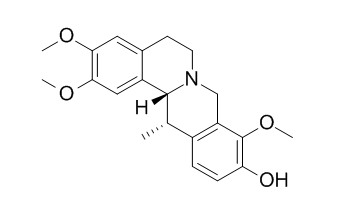Yuanhunine
Reference standards.
Inquire / Order:
manager@chemfaces.com
Technical Inquiries:
service@chemfaces.com
Tel:
+86-27-84237783
Fax:
+86-27-84254680
Address:
1 Building, No. 83, CheCheng Rd., Wuhan Economic and Technological Development Zone, Wuhan, Hubei 430056, PRC
Providing storage is as stated on the product vial and the vial is kept tightly sealed, the product can be stored for up to
24 months(2-8C).
Wherever possible, you should prepare and use solutions on the same day. However, if you need to make up stock solutions in advance, we recommend that you store the solution as aliquots in tightly sealed vials at -20C. Generally, these will be useable for up to two weeks. Before use, and prior to opening the vial we recommend that you allow your product to equilibrate to room temperature for at least 1 hour.
Need more advice on solubility, usage and handling? Please email to: service@chemfaces.com
The packaging of the product may have turned upside down during transportation, resulting in the natural compounds adhering to the neck or cap of the vial. take the vial out of its packaging and gently shake to let the compounds fall to the bottom of the vial. for liquid products, centrifuge at 200-500 RPM to gather the liquid at the bottom of the vial. try to avoid loss or contamination during handling.
Journal of Natural Remedies2024, 24(3):555ĘC575.
Food Chem.2020, 313:126079
Life Sci.2019, 216:259-270
J Sci Food Agric.2024, 104(7):4425-4437.
Pharm Biol.2017, 55(1):360-366
Cells.2021, 10(10):2633.
Oncotarget.2015, 6(31):30831-49
Molecules.2024, 29(5):1048.
Food Bioscience2023, 59:103903
J AOAC Int.2023, 106(1):56-64.
Related and Featured Products
Biol Pharm Bull. 2004 Aug;27(8):1270-4.
The combination of rat mast cell and rabbit aortic smooth muscle is the simple bioassay for the screening of anti-allergic ingredient from methanolic extract of Corydalis tuber.[Pubmed:
15305035 ]
METHODS AND RESULTS:
We have assessed the release of histamine from mast cells by smooth muscle contraction. 0.3 microg/ml compound 48/80 showed no effect on concentration-response relationship of histamine in rabbit aorta. Compound 48/80 induced release of histamine from rat mast cells. When aorta was stimulated by compound 48/80 in the presence of mast cells, contraction was evoked in concentration-dependent manner. This mast cell-dependent contraction was completely blocked by H1 receptor antagonist, 1 microM diphenhydramine. When mast cells was treated with compound 48/80 inhibitor benzalkonium chloride, mast cell-dependent contraction was inhibited, although benzalkonium chloride itself showed no effect on concentration-response relationship of histamine in rabbit aorta. At high concentration of 10 microg/ml, benzalkonium chloride itself evoked histamine release from mast cells and indeed inhibitory effect of 10 microg/ml benzalkonium chloride on mast cell-dependent contraction was lower than that of 3 microg/ml. We have applied this bioassay to search anti-allergic ingredient from a total methanolic extract of Corydalis tuber (Corydalis turtschaninovii BESSER forma yanhusuo Y. H. CHOU et C. C. HSU). Successively, we have isolated five fractions. The fractions I-IV are identified to be corybulbine (1), tetrahydropalmatine (2), corydaline (3) and Yuanhunine (4), respectively. Main component of fraction V is the mixture of 3 and canadine (5). Fractions II and V significantly inhibited mast cell-dependent contraction in rabbit aorta as well as inhibited histamine release from rat mast cells. Furthermore, fractions I, III and V inhibited histamine-induced contraction in rabbit aorta at non-competitive manner.
CONCLUSIONS:
From these results, combination of rat mast cells and rabbit aorta is good bioassay to search the anti-allergic ingredient, and we have obtained effective fractions from Corydalis tuber using this assay.
J Sep Sci. 2012 May;35(9):1102-9.
In vitro metabolism of corydaline in human liver microsomes and hepatocytes using liquid chromatography-ion trap mass spectrometry.[Pubmed:
22689485 ]
Corydaline is a pharmacologically active isoquinoline alkaloid isolated from Corydalis tubers. It exhibits the antiacetylcholinesterase, antiallergic, antinociceptive, and gastric emptying activities. The purposes of this study were to establish in vitro metabolic pathways of corydaline in human liver microsomes and hepatocytes by identification of their metabolites using liquid chromatography-ion trap mass spectrometry.
METHODS AND RESULTS:
Human liver microsomal incubation of corydaline in the presence of an NADPH-generating system resulted in the formation of nine metabolites, namely, four O-desmethylcorydaline [M1 (Yuanhunine), M2 (9-O-desmethylcorydaline), M3 (isocorybulbine), and M4 (corybulbine)], three di-O-desmethylcorydaline [M5 (9,10-di-O-desmethylcorydaline), M6 (2,10-di-O-desmethylcorydaline), and M7 (3,10-di-O-desmethylcorydaline)], M8 (hydroxyYuanhunine), and M9 (hydroxycorydaline). Incubation of corydaline in human hepatocytes produced four metabolites including M1, M5, M6, and M9.
CONCLUSIONS:
O-Demethylation and hydroxylation were the major metabolic pathways for the metabolism of corydaline in human liver microsomes and hepatocytes.



